DOES YOUR SCRIPT SMELL?
by William C. Martell
Novelists, short story writers and poets are free to use all six senses in telling their
stories. They can use hearing: the sound of a far away foghorn, dialogue between
characters. Smell: the pleasant odor of a pine wood fire on an autumn day. Sight:
showing an incident or a character doing something that moves the story forward.
Touch: the smooth feel of velvet, hot asphalt on bare feet on a summer day. Taste:
sweet and sour pork, that strange aftertaste from hot Ovaltine. Even that sixth sense
can be used: there's a weird telepathic link between the characters and the reader in a
novel... we often know what they are thinking and feeling.
But screenwriters are limited to only two of the senses to tell our stories: Sight and
Sound. That's what makes screenwriting so difficult. We only have a third of the tools
of a novelist to tell our stories, and we don't even get the good tools! This means that
some stories that can be easily told in a novel are impossible to tell on the screen.
Some scenes that are used to explore character or move the plot forward in a novel or
short story are impossible to use in a screenplay. For example....
SMELL
Our leading lady Jane may have finally met Mister Right, a guy named Ken who she
has had numerous phone conversations with. Ken is intelligent, witty, charming
considerate, and tender. On the phone they can talk as if they are old friends. Jane
was a little nervous when they swapped photos, but Ken is fairly attractive. Not Mel
Gibson perfect, but a very handsome man. So they arrange a date.
Ken arrives at Jane's apartment well dressed, well groomed, and with a bouquet of
flowers... overpoweringly sweet smelling flowers. Perfumey. Jane puts the flowers in a
vase to get rid of them, then realizes that strong perfume smell is coming from Ken, not
the flowers. The guy must be wearing a gallon of cheap aftershave. In the apartment
elevator, the aftershave is deadly. Jane moves away from Ken, but there is no
escaping that sweet smell! Ken may look and sound like the perfect man, but he
stinks!
In a novel this scene works. On screen, it won't work. We are limited to what we can
see and what we can hear. If we have Jane mention the strong aftershave smell, the
scene is over. Ken becomes offended, and the date doesn't continue.
So let's come up with ways that we might SHOW Jane's predicament in the elevator.
We can have her wave her hand in front of her nose to dissipate the smell... but we
have no way of knowing what the smell is. The majority of the audience is going to
believe that Ken may have a flatulence problem. We can have Jane hold her hand
over her nose and mouth, but this still doesn't identify the SOURCE of the odor. Ken is
a well dressed, well groomed man. We don't have any VISUAL INFORMATION to tell
us what the smell is. If we take Ken out of the elevator and place a ragged, unwashed
Homeless Man in the elevator with Jane, when she waves her hand or covers her nose
and mouth, the audience will assume the source of the odor is the unwashed homeless
man. The homeless man creates VISUAL INFORMATION for the audience - we know
what unwashed people smell like and we call up that odor in our imaginations. But Ken
is a clean, well groomed man. What could possibly be the source of his odor? One way
to give the audience the necessary visual information is to SHOW Ken pouring on the
aftershave before the date. But this telegraphs the punch line to the "flower gag",
ruining the joke. The scene no longer works... but at least the audience will know that
Ken doesn't have a flatulence problem! You can't see a smell. You can show a
character's REACTION to a smell, but without the VISUAL INFORMATION that
identifies that smell to the audience the scene won't work.
TASTE
You could write an entire novel about a character who travels the world tasting every
exotic food he can find. But let's stay closer to home and look at a scene where Margie
cooks a gourmet meal for her husband Larry's 35th birthday. She taped a show off The
Food Channel showing how to make the very meal they had on their honeymoon at a
five star restaurant. Margie has secretly bought all of the ingredients, prepared the
dinner, and now surprises Larry. Wow! The food looks great! Larry takes a bite,
chews... but doesn't swallow. Somehow Margie has mistakenly used ground cinnamon
instead of ground oregano. The food tastes terrible! Larry doesn't want to offend
Margie, so he cleans his plate... one agonizing bite at a time. Yech!
The problem with this scene on film is that we don't know that anything is wrong with
the food. Margie serves dinner, Larry eats the dinner with a smile. Any actions on
Larry's part that tip us off that the food doesn't taste good will also tip off Margie.
Ruining the birthday celebration and maybe even leading to the end of their marriage.
We can't see what Larry tastes, we can only see his reaction. We can show him take a
mouthful of food, smile at Margie, then bring his napkin up to wipe his mouth... and
secretly spit the food into it. When Margie goes to the kitchen for something, we can
have Larry quickly scrape his food back onto the serving tray. "That was delicious!" he
says when Margie returns. "Would you like some more? There's plenty," she says as
she scoops up the same food Larry just returned to the serving tray and
puts it back on Larry's plate. Because we are dealing with physical actions, VISUAL
INFORMATION, we now understand that there's something wrong with the food... but
we will never know what. We can't SEE the taste of cinnamon instead of oregano. For
all we know, the food tastes like sweat socks, or is poisoned, or is spoiled, or is just a
dish that Larry doesn't care for. Scenes that deal with taste just don't work on film.
TOUCH
What about touch? Though we can see texture on screen, we can't feel it. In a novel
you can write a scene where Chuck is dancing the night away with a beautiful girl
named Bobbi. The romantic sparks are flying. Finally Chuck and Bobbi step outside.
They kiss in the moonlight. First tentatively, then with increasing passion. Chuck feels
himself becoming aroused. When they kiss once more, Chuck touches Bobbi's face,
caressing up her cheeks... feeling the bristles of beard stubble below the freshly
shaved skin... realizing that he has been making out with a man! Chuck pulls away,
feeling sick to his stomach.
That scene works in a novel, but has no chance of working on screen. We can't show
what Chuck feels. If we show that Bobbi has beard stubble, we have ruined the scene.
The audience will know that Bobbi is a man and wonder why Chuck can't figure it out.
Is Chuck stupid? Is he cruising for a transvestite on purpose? But if we take away the
VISUAL INFORMATION of the beard stubble, we have Chuck feeling her cheek and
pulling away. Why? We don't know. There is no cause for the effect. For all we know,
he just regrets kissing her for some reason... or maybe she has a flatulence problem,
too. Movies can't show what something feels like. We can't know that he's feeling
aroused (okay, maybe we can, but not without being vulgar). We can't know that he's
feeling sick to his stomach unless we have a physical action of some sort. He can
vomit. He can clutch his stomach. He can hold a hand over his mouth... but what if we
want Chuck to subtly pull away from Bobbi? The viewing audience can't see the
stubble under Bobbi's cheek. We can show a texture, but we can't feel it.
THE SIXTH SENSE
The best tool a novelist has is that sixth sense, and it's the one completely unavailable
to screenwriters. Novels often take us inside the minds of characters. It's called
omniscience. We know their emotions, their motivations, their thoughts, their memories
of things past. Entire novels have been written where nothing physically happens, but
the character's thoughts and opinions tell the story. The character may be eating a
cookie and remembering the events of their life, or calmly dealing with life while they
slowly descend into madness. Our character may take a bite of exotic food and
remember the woman he was with the first time he tasted the dish.
In a novel, Joe may absolutely hate his boss Clayton. Clayton may be an imbecile
whose poor business decisions have lost the company millions. Joe doesn't trust
Clayton - he knows that if things go wrong, Clayton will blame Joe for the mistake. Joe
is afraid that Clayton's mistakes may ruin the company and Joe will need to find a new
job. Joe may come up with a really clever insult in response to everything Clayton says,
but his verbal responses are polite and reverential. All of these things may be going on
below the surface during a business meeting where Joe treats Clayton with the basic
level of respect shown to a boss. Or the conversation may be about something
completely unrelated to business... like golf.
But remove our sixth sense, and we have a boring conversation about golf or business.
We don't know any of the back story or motivations. We don't know that when Clayton
comes up with an iffy idea and Joe agrees with it, that's he's secretly horrified.
Screenplays deal with SIGHT and SOUND, not psychic abilities. This scene won't work
on film because the information the audience needs to understand the scene can not
be communicated in a film.
Watch out for words like "realizes", "thinks" and "knows".... all are sixth sense words
and precede a section of description that is neither sight nor sound. Something that will
NOT communicate on film at all. If you write, "George knows that Ralph will betray
him", you create a situation where the reader knows something that the audience can
never know. I have read scripts that were bought based on the story elements on the
page that just don't transfer to the screen. They bought a beautifully written script, but
all of the king's horses and all of the king's men could never make that script into a
good film. The important information had to remain on the page because it could
neither be seen nor heard.
GREAT NOVEL / BAD MOVIE
There was a saying in the golden days of Hollywood that great novels made lousy
movies, and lousy novels made great movies. The reason behind this saying was that
characters forced to wrestle with moral decisions, or characters who make profound
discoveries and characters whose problems can't be seen or heard on the screen,
leaving us with a film that may have a simple plot and boring, inactive lead characters.
The elements that made the novel great were going on between the character's ears!
So take care when choosing your story to pick a conflict and character growth that
works on film. A story about an alcoholic trying to live his life a day at a time may be
filled with constant conflict - walking past the bar he used to hang out in on his way to
work, having a waiter ask if he'd like a cocktail before ordering when he goes out to
dinner, dealing with a tense situation that might be "easier to get through with a little
liquid lubrication". But these struggles are INTERNAL. The major conflict in this story
takes place within the character... where we can't see it. The only way we can hear this
conflict is through exposition - one character TELLING another what he's thinking.
Remember, the first rule of film is Show Don't Tell.
Some stories work better for novels than screenplays. If the story can't be told using
only Sight and Sound, you're better off telling it in another medium. Does this mean the
stories you chose for screenplays have to be all surface? Simple? Dumb? Not at all!
They just have to be visual. You have to be able to show the complex emotional
conflicts through...
PHYSICAL ACTIONS
We can't know how someone feels, we have to SHOW how someone feels. We have
to find the action that illustrates the emotion. That's easy if the emotion is sadness, and
you can show the character crying... Or if the emotion is anger and you can show the
character breaking something. But for subtle emotions, complex emotions, and
combinations of emotions it can be challenging. How do you show disappointment?
How do you show suspicion? How do you show a broken heart?
In NORTH BY NORTHWEST Cary Grant suspects that Eva Marie Saint has set him up to
be killed in the cornfield. He never says this in the scene but his actions tell the story.
When Saint races across the room to embrace him (after an awkward moment), Grant
does not hug her back. Instead, his fists are clenched in controlled rage. He tries not to
touch her, even though she has her arms wrapped around him. We SEE how he feels.
The key is to create scenes that illustrate the character. You may have to take every
scene in your script and come up with an action or decision designed to show us each
emotion the audience needs to understand. Turn each emotion into an action, and
feelings into visual information.
CHEATS
Like every rule, the SIGHT & SOUND rule has an exception or two. Both exceptions
have to do with an actor's performance: things that we CAN see... if the actor playing
the role has the information. When you are introducing a character, you're allowed to
give us some basic information - He's a nice guy, he's mean as a snake, he's
sarcastic... These are things we may not be able to see, but they shade an actor's
performance. Gene Hackman can play a friendly, likable guy who helps the hero or a
double crossing villain -- the dialogue may be the same in a scene, but the actor's
performance of those lines will be different. We will be able to SEE that performance.
To HEAR the way the lines are delivered. If we don't give this information to the actor
(and reader) they will eventually discover that Hackman is the bad guy... but it may
confuse them. Adding a line in the character description that clears up the confusion is
acceptable.
The same goes for actions used to illustrate an emotion. Some emotions are "playable"
(an actor can show them through expression) and some are not. In my script BAKER
TOUCH I have a police detective running her hand over the desk of her recently killed
partner. There are a hundred ways for an actor to run her finger across a desk. We
don't want the way that checks for dust, we want the way that's a caress. Some of this
can be solved by word choice, but we want to make sure the actor knows what
expression to put on her face. If we just have the character run her finger over the desk
and frown, we may think it's because of waxy build up. So we cheat in the emotion to
clarify what kind of frown the character has. We can't see the emotion, but we CAN
see the action and the expression. No psychic abilities involved - we're still describing
things that can be seen or heard.
Sight and sound. In a novel you can tell us the motivations, past histories, secret fears,
and subtle relationships between characters... but in a screenplay we are faced with
the challenge of only using two of the six senses. Finding stories that can be told
through physical actions and dialogue. SIGHT and SOUND is more than just a British
film magazine, it's one of the main things to consider when you are choosing your story.
FADE OUT
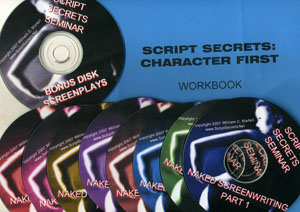
Pre Halloween Deal! Naked Screenwriting @ HALF PRICE as MP3s! Full Set: $50.
BRAND NEW!
DESCRIPTION & VOICE Blue Book!
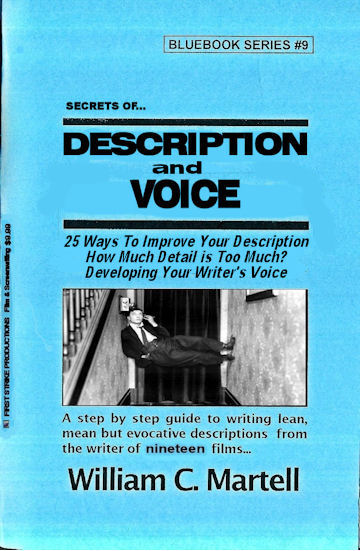
DESCRIPTION & VOICE Blue Book.
IS HALF OF YOUR STORY IN TROUBLE?
Most screenplays are about a 50/50 split between dialogue and description - which means your description is just as important as your dialogue. It just gets less press because the audience never sees it, the same reason why screenwriters get less press than movie stars. But your story will never get to the audience until readers and development executives read your script... so it is a very important factor. Until the movie is made the screenplay is the movie and must be just as exciting as the movie. So how do you make your screenplay exciting to read? Description is important in a novel as well, and the “audience” does read it... how do we write riveting description?
Only $4.99!
Tips FAQ

My New Script Secrets Newsletter!

NEW BOOKS!
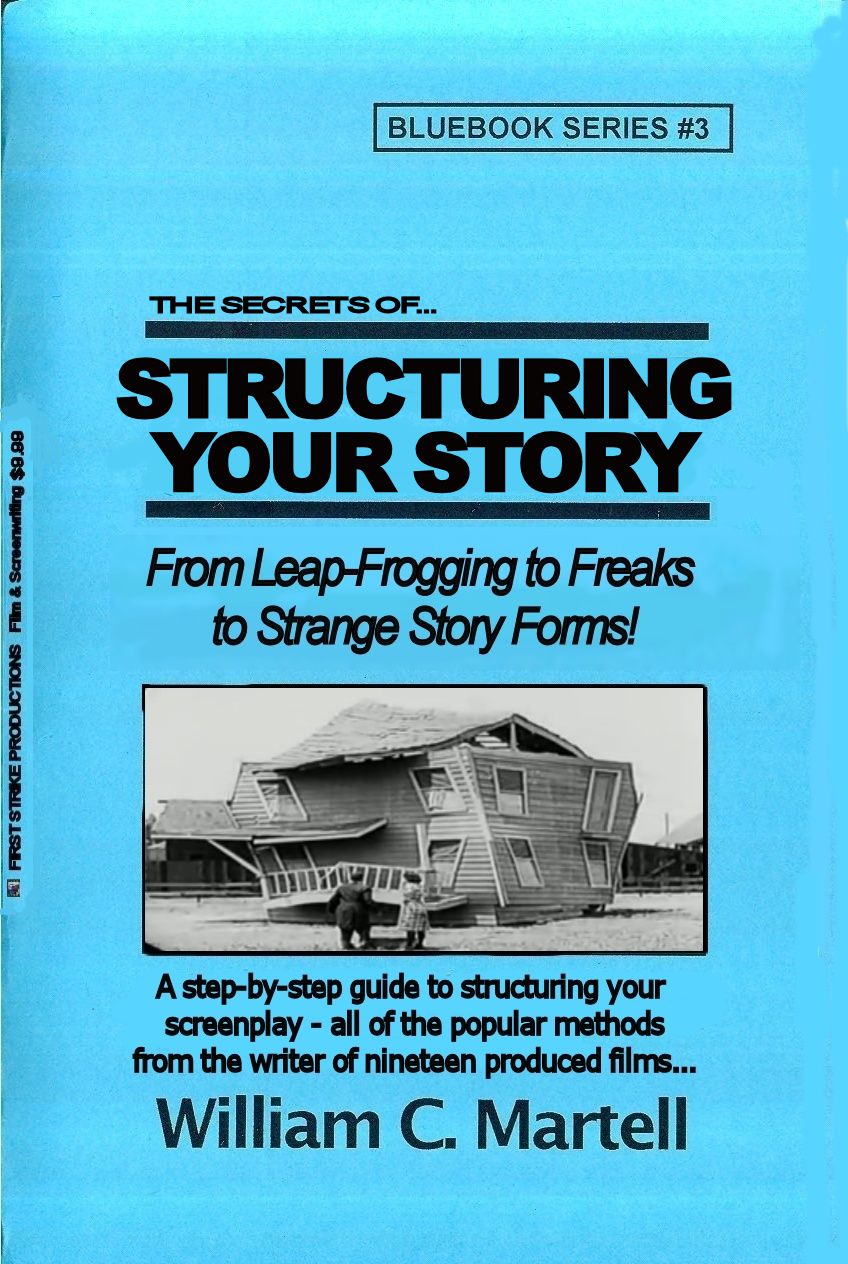
NEW AND HOT!
*** STRUCTURING YOUR STORY *** - For Kindle!
William Goldman says the most important single element of any screenplay is structure. It’s the skeleton under the flesh and blood of your story. Without it, you have a spineless, formless, mess... a slug! How do you make sure your structure is strong enough to support your story? How do you prevent your story from becoming a slug? This Blue Book explores different types of popular structures from the basic three act structure to more obscure methods like leap-frogging. We also look at structure as a verb as well as a noun, and techniques for structuring your story for maximum emotional impact. Most of the other books just look at *structure* and ignore the art of *structuring* your story. Techniques to make your story a page turner... instead of a slug!
Only $4.99 - and no postage!
NO KINDLE REQUIRED! Get the *free* app (any device, except your Mr. Coffee) on the order page on Amazon!
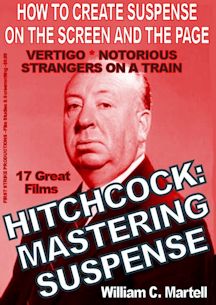
LEARN SUSPENSE FROM THE MASTER!
*** HITCHCOCK: MASTERING SUSPENSE *** - For Kindle!
Alfred Hitchcock, who directed 52 movies, was known as the *Master Of Suspense*; but what exactly is suspense and how can *we* master it? How does suspense work? How can *we* create “Hitchcockian” suspense scenes in our screenplays, novels, stories and films?
This book uses seventeen of Hitchcock’s films to show the difference between suspense and surprise, how to use “focus objects” to create suspense, the 20 iconic suspense scenes and situations, how plot twists work, using secrets for suspense, how to use Dread (the cousin of suspense) in horror stories, and dozens of other amazing storytelling lessons. From classics like “Strangers On A Train” and “The Birds” and “Vertigo” and “To Catch A Thief” to older films from the British period like “The 39 Steps” and “The Man Who Knew Too Much” to his hits from the silent era like “The Lodger” (about Jack The Ripper), we’ll look at all of the techniques to create suspense!
Only $5.99

BRAND NEW!
*** THE BOURNE MOVIES
All five "Bourne" movies (including "Legacy" and it's potential sequels) - what are the techniques used to keep the characters and scenes exciting and involving? Reinventing the thriller genre...
or following the "formula"? Five films - each with an interesting experiment! A detailed analysis of each
of the films, the way these thrillers work... as well as a complete list of box office and critical
statistics for each film. This book is great for writers, directors, and just fans of the series.
Only $3.99 - and no postage!

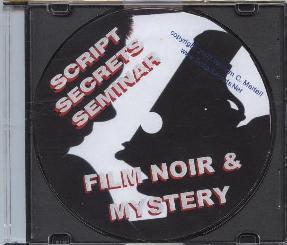
AUDIO CLASS!
NOIR & MYSTERY80 minute CD packed with information on writing Film Noir and Mystery scripts. Using examples from CHINATOWN to OUT OF THE PAST to DOUBLE INDEMNITY you'll learn how to create stories in this dark, twisted genre. How to plant clues, red herrings, suspects, victims, spider women, fallen heroes, the funhouse mirror world of noir supporting characters... and the origins of Film Noir in literature Noir dialogue and how noir endings are different than any other genre. All of the critical elements necessary to write in this critically popular genre.
The Noir & Mystery Class is only $15 (plus $5 S&H). First 20 on Limited Black Disk!
RECESSION SALE! $5 OFF!
IDEAS AND CREATIVITY - 80 minute CD packed with information. Tools to find ideas that are both personal *and* commercial. Hollywood wants scripts with High Concept stories... but not stupid scripts. Developing *intelligent* high concept ideas. How to turn your personal story into a blockbuster - or find your personal story in a high concept idea. Brainstorming and being creative. Ideas and Creativity is $10.00 (plus $5 S&H)
WRITING INDIES - Writing an Indie film? This class covers everything you need to know - from Central Locations to Confined Cameos. Using examples from SWINGERS, THE COOLER, STATION AGENT and others, this 80 minute CD is packed with information. How Indoe films challenge the audience (while mainstream films reassure the audience). Structures, using BOYS DON'T CRY, RUN LOLA RUN, HILARY & JACKIE, and others as example. Writing for a budget, writing for non-actors, getting the most production value out of your budget. Writing Indies is $10.00 (plus $5 S&H)
WRITING HORROR - The essentials of a horror screenplay - what do ROSEMARY'S BABY, NIGHT OF THE LIVING DEAD, THE EXORCIST, BRIDE OF FRANKENSTEIN, THE OTHERS and OPEN WATER have in common? This class will tell you! All of the critical elements necessary to write a script that scares the pants off the audience. Writing Horror is $10.00 (plus $5 S&H).
Click here for more information on CLASS CDs!
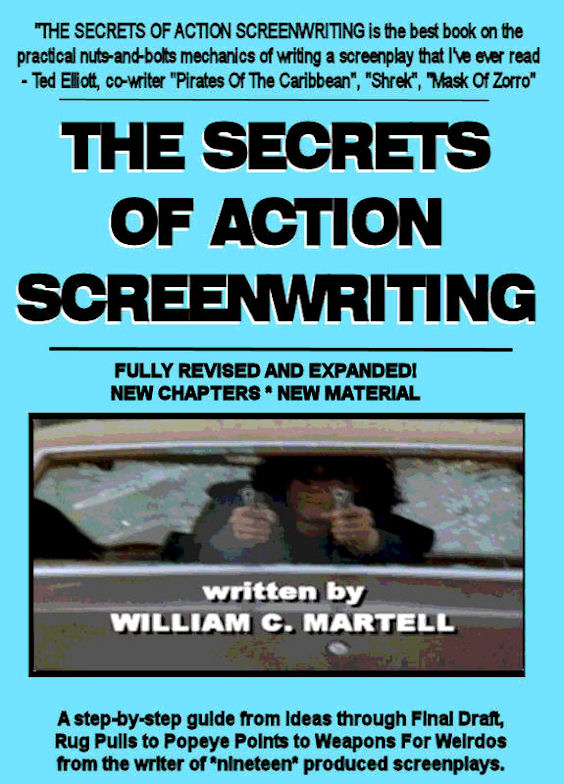
THE BOOK THAT STARTED IT ALL!
*** THE SECRETS OF ACTION SCREENWRITING *** - For Kindle!
*** THE SECRETS OF ACTION SCREENWRITING *** - For Nook!
Why pay $510 for a used version of the 240 page 2000 version that used to retail for $21.95? (check it out!) when
you can get the NEW EXPANDED VERSION - over 500 pages - for just $9.99? New chapters, New examples, New techniques!
"SECRETS OF ACTION SCREENWRITING is the
best book on the practical nuts-and-bolts mechanics of writing a screenplay I've ever read."
- Ted Elliott, co-writer of MASK OF ZORRO, SHREK, PIRATES OF THE CARIBBEAN and the sequels (with Terry Rossio). (ie; 4 of the top 20 Box Office Hits Of ALL TIME.)
Only $9.99 - and no postage!
READY TO BREAK IN?
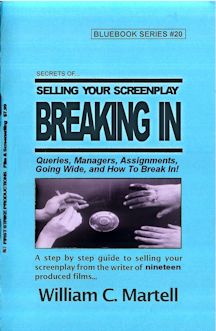
NEW!
*** BREAKING IN BLUE BOOK *** - For Kindle!
Should really be called the BUSINESS BLUE BOOK because it covers almost everything you will need to
know for your screenwriting career: from thinking like a producer and learning to speak their language,
to query letters and finding a manager or agent, to making connections (at home and in Hollywood) and
networking, to the different kinds of meetings you are will have at Studios, to the difference between
a producer and a studio, to landing an assignment at that meeting and what is required of you when you
are working under contract, to contracts and options and lawyers and... when to run from a deal!
Information you can use *now* to move your career forward! It's all here in the Biggest Blue Book yet!
Print version was 48 pages, Kindle version is over 400 pages!
$4.99 - and no postage!
NO KINDLE REQUIRED! Get the *free* app (any device, except your Mr. Coffee) on the order page on Amazon!

STORY: WELL TOLD!
*** STORY: WELL TOLD *** - For Kindle!
This book takes you step-by-step through the construction of a story... and how to tell a story well, why Story always starts with character... but ISN'T character, Breaking Your Story, Irony, Planting Information, Evolving Story, Leaving No Dramatic Stone Unturned, The Three Greek Unities, The Importance Of Stakes, The Thematic Method, and how to create personal stories with blockbuster potential. Ready to tell a story?
Print version was 48 pages, Kindle version is over 85,000 words - 251 pages!
Only $4.99 - and no postage!
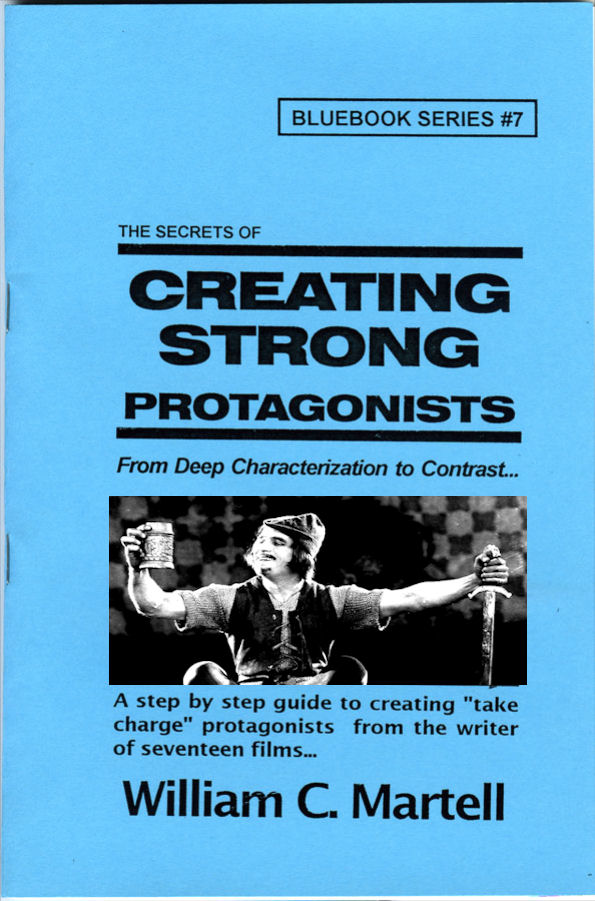
MOVIES ARE CHARACTERS!
*** CREATING STRONG PROTAGONISTS *** - For Kindle!
*** CREATING STRONG PROTAGONISTS *** - For Nook!
Expanded version with more ways to create interesting protagonists! A step-by-step guide to creating "take charge" protagonists. Screenplays are about characters in conflict... characters in emotional turmoil... Strong three dimensional protagonists who can find solutions to their problems in 110 pages. But how do you create characters like this? How do you turn words into flesh and blood? Character issues, Knowing Who Is The Boss, Tapping into YOUR fears, The Naked Character, Pulp Friction, Man With A Plan, Character Arcs, Avoiding Cliche People, Deep Characterization, Problem Protagonists, 12 Ways To Create Likable Protagonists (even if they are criminals), Active vs. Reactive, The Third Dimension In Character, Relationships, Ensemble Scripts, and much, much more. Print version is 48 pages, Kindle version is once again around 205 pages!
ONLY $4.99 - and no postage!
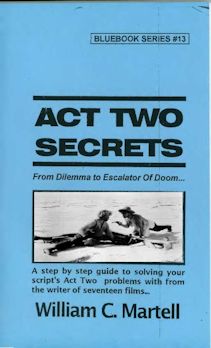
ACT TWO SOLUTIONS!
*** ACT TWO SECRETS *** - For Kindle!
Expanded version with more techniques to help you through the desert of Act Two! Subjects Include: What Is Act Two? Inside Moves, The 2 Ps: Purpose & Pacing, The 4Ds: Dilemma, Denial, Drama and Decision, Momentum, the Two Act Twos, Subplot Prisms, Deadlines, Drive, Levels Of Conflict, Escalation, When Act Two Begins and When Act Two Ends, Scene Order, Bite Sized Pieces, Common Act Two Issues, Plot Devices For Act Two, and dozens of others. Over 67,000 words (that’s well over 200 pages) of tools and techniques to get you through the desert of Act Two alive!
Print version was 48 pages, Kindle version is well over 200 pages!
ONLY $4.99 - and no postage!
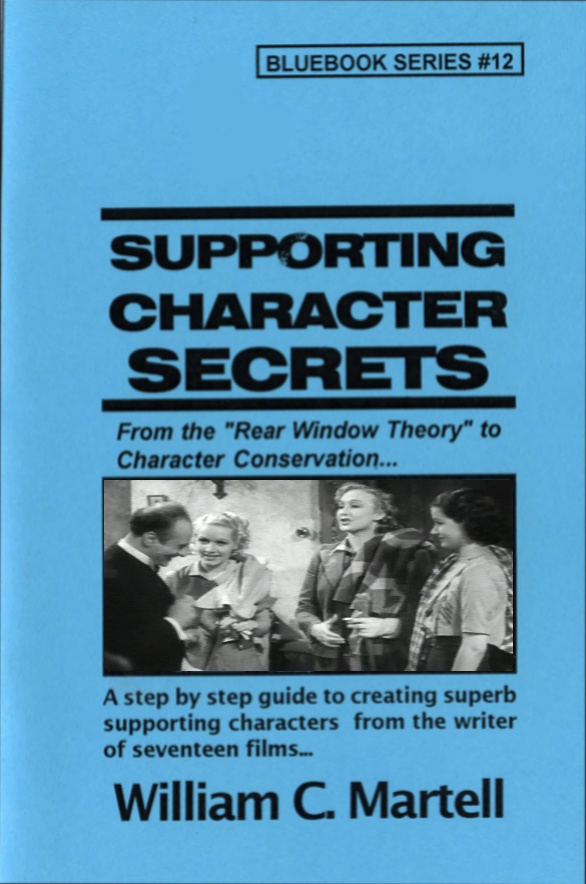
SUBPLOTS?
*** SUPPORTING CHARACTER SECRETS *** - For Kindle! (Exclusive)
Expanded version with more techniques to flesh out your Supporting Characters and make them individuals. Using the hit movie BRIDESMAIDS as well as other comedies like THE HANGOVER and TED and HIGH FIDELITY and
40 YEAR OLD VIRGIN and many other examples we look at ways to make your Supporting Characters come alive on the page.
Print version was 48 pages, Kindle version is around 170 pages!
ONLY $4.99 - and no postage!
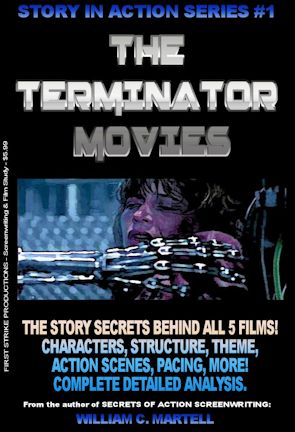
Over 240 pages!
*** THE TERMINATOR MOVIES *** - For Kindle!
He's back! The release of "Terminator: Genisys" (now on BluRay) is set to begin a new trilogy in
the Terminator story... 31 years after the first film was released. What draws us to these films about
a cybernetic organism from the future sent back in time? Why is there a new proposed trilogy every few
years? This book looks at all five Terminator movies from a story standpoint - what makes them work
(or not)? What are the techniques used to keep the characters and scenes exciting and involving? How
about those secret story details you may not have noticed? Containing a detailed analysis of each of
the five films so far, this book delves into the way these stories work... as well as a complete list of
box office and critical statistics for each film. This book is great for writers, directors, and just
fans of the series.
ONLY $3.99 - and no postage!

ADVICE FROM 1920!
*** VINTAGE #1: HOW TO WRITE PHOTOPLAYS *** - For Kindle!
***
Screenwriting books have been around as long as films have. This series reprints vintage screenwriting books with a new introduction and history, plus new articles which look at how these lessons from almost 100 years ago apply to today’s screenplays. Anita Loos book is filled with information which still applies.
In addition to the full text of the original book, you get the full screenplay to Miss Loos' hit THE LOVE EXPERT, plus several new articles on the time period and women in Hollywood.
ONLY $2.99 - and no postage!
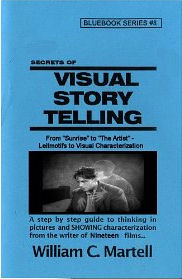
I WRITE PICTURES!
*** VISUAL STORYTELLING *** - For Kindle! (exclusive)
Show Don't Tell - but *how* do you do that? Here are techniques to tell stories visually! Using Oscar Winning Films and Oscar Nominated Films as our primary examples: from the first Best Picture Winner "Sunrise" (1927) to the Oscar Nominated "The Artist" (which takes place in 1927) with stops along the way Pixar's "Up" and Best Original Screenplay Winner "Breaking Away" (a small indie style drama - told visually) as well as "Witness" and other Oscar Winners as examples... plus RISE OF THE PLANET OF THE APES. Print version is 48 pages, Kindle version is over 200 pages!
ONLY $4.99 - and no postage!
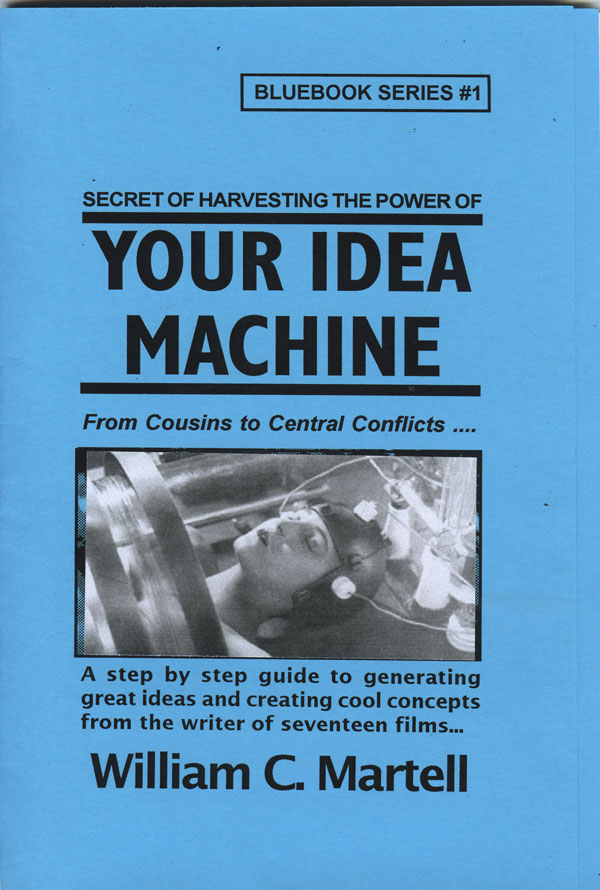
BEST SELLER!
*** YOUR IDEA MACHINE *** - For Kindle!
*** YOUR IDEA MACHINE *** - For Nook!
Expanded version with more ways to find great ideas! Your screenplay is going to begin with an idea. There are good ideas and bad ideas and commercial ideas and personal ideas. But where do you find ideas in the first place? This handbook explores different methods for finding or generating ideas, and combining those ideas into concepts that sell. The Idea Bank, Fifteen Places To Find Ideas, Good Ideas And Bad Ideas, Ideas From Locations And Elements, Keeping Track Of Your Ideas, Idea Theft - What Can You Do? Weird Ways To Connect Ideas, Combing Ideas To Create Concepts, High Concepts - What Are They? Creating The Killer Concept, Substitution - Lion Tamers & Hitmen, Creating Blockbuster Concepts, Magnification And The Matrix, Conflict Within Concept, Concepts With Visual Conflict, Avoiding Episodic Concepts, much more! Print version is 48 pages, Kindle version is over 175 pages!
Only $4.99 - and no postage!

PRO DIALOGUE TECHNIQUES!
*** DIALOGUE SECRETS *** - For Kindle!
*** DIALOGUE SECRETS *** - For Nook!
Expanded version with more ways to create interesting dialogue! How to remove bad dialogue (and what *is* bad dialogue), First Hand Dialogue, Awful Exposition, Realism, 50 Professional Dialogue Techniques you can use *today*, Subtext, Subtitles, Humor, Sizzling Banter, *Anti-Dialogue*, Speeches, and more. Tools you can use to make your dialogue sizzle! Special sections that use dialogue examples from movies as diverse as "Bringing Up Baby", "Psycho", "Double Indemnity", "Notorious", the Oscar nominated "You Can Count On Me", "His Girl Friday", and many more! Print version is 48 pages, Kindle version is over 175 pages!
Only $4.99 - and no postage!

Use your creative energy to focus on the content; let Final Draft take care of the style. Final Draft is the number-one selling application specifically designed for writing movie scripts, television episodics and stage plays. Its ease-of-use and time-saving features have attracted writers for almost two decades positioning Final Draft as the Professional Screenwriters Choice. Final Draft power users include Academy, Emmy and BAFTA award winning writers like Oliver Stone, Tom Hanks, Alan Ball, J.J. Abrams, James Cameron and more.
* * * Buy It!
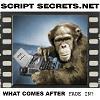
|
|
|
|
|
SCRIPT SECRETS STORE
|
|
 SCRIPT SECRETS STORE
From Typing Monkey coffee cups to messenger bags to T shirts - everything a screenwriter needs to look sharp while working on that Oscar nomination!
Get your Script Secrets Coffee Cup today!
SCRIPT SECRETS STORE
From Typing Monkey coffee cups to messenger bags to T shirts - everything a screenwriter needs to look sharp while working on that Oscar nomination!
Get your Script Secrets Coffee Cup today!
|
|
E BOOKS PAGE
|
|
 E BOOKS: New Blue Books and Novelettes!
E BOOKS: New Blue Books and Novelettes!
I am expanding all of the Blue Books from around 44 pages of
text to around 200 pages! Some are over 250 pages! See what is availabale and what is coming soon!Also, I've been writing Novelletes and there
will soon be novels.
E BOOKS: BLUE BOOKS & NOVELLETES
|
|
ONLINE CLASSES
|
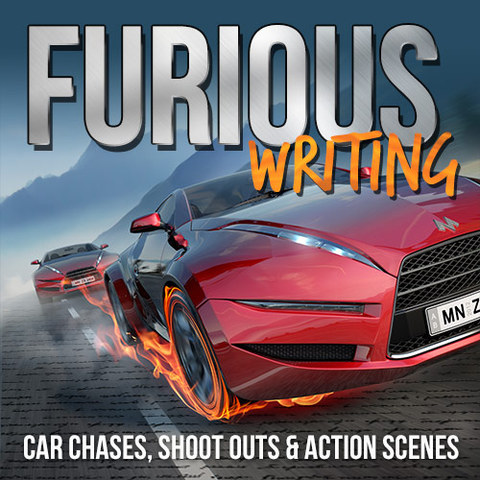
|
|
MY OTHER SITES
|
|
B MOVIE WORLD
Cult Films, Exploitation, Bikers & Women In Prison, Monster Movies.
FIRST STRIKE PRODUCTIONS
Producing my own scripts, investment possibilities, pipe dreams.
|
|
NAKED SCREENWRITING CDs
|
|
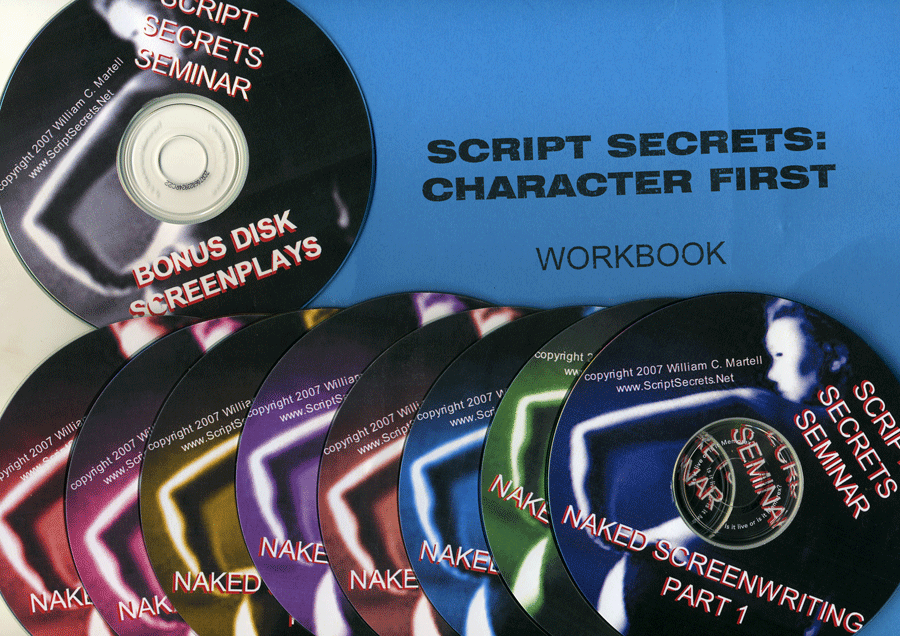 The NAKED SCREENWRITING CLASS ON CD!
The 2001 London Class on 8 CDs! Recorded *live* the morning after the Raindance Film Festival
wrapped. The two day class on 8CDs, plus a workbook, plus a bonus CD with PDFs.
The NAKED SCREENWRITING CLASS ON CD!
The 2001 London Class on 8 CDs! Recorded *live* the morning after the Raindance Film Festival
wrapped. The two day class on 8CDs, plus a workbook, plus a bonus CD with PDFs.
The 2 Day Class on CD!
|
|
BOOKSTORE
|
|
Every screenwriting book in the world!
SCREENWRITER'S BOOKSTORE
In Association With Amazon.com
From the latest screenwriting book to
guides for finding agents and producers... all with at the
Amazon.com discount!
|
|
BOOKLETS & PRODUCTS
|
|
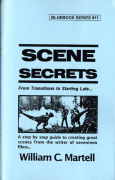 FIRST STRIKE BLUE BOOKS
FIRST STRIKE BLUE BOOKS
Each Blue Book is 48
pages and focuses on a different aspect of screenwriting. Dialogue. Visual Storytelling. Your First Ten Pages. Act 2 Booster. Protagonists. Great Endings.
Seventeen Blue Books now available!
THE SECRETS OF ACTION SCREENWRITING The Best Nuts & Bolts Screenwriting Book On The
Market!
|
|
BILL'S CORNER
|
|
My
nineteen produced films, interviews with me in magazines,
several sample scripts, my available scripts list... And MORE!
...............................BILL'S CORNER
Available Scripts
|
|
CLASSES ON CD
|
|
 CLASSES ON CD! Take a class on CD! GUERRILLA MARKETING - NO AGENT? NO PROBLEM! and WRITING THRILLERS (2 CDs). Full length classes on CD. Now Available: IDEAS & CREATIVITY, WRITING HORROR, WRITING INDIE FILMS, more!
CLASSES ON CD! Take a class on CD! GUERRILLA MARKETING - NO AGENT? NO PROBLEM! and WRITING THRILLERS (2 CDs). Full length classes on CD. Now Available: IDEAS & CREATIVITY, WRITING HORROR, WRITING INDIE FILMS, more!
Take classes on CD!
|
|
|
|
|

